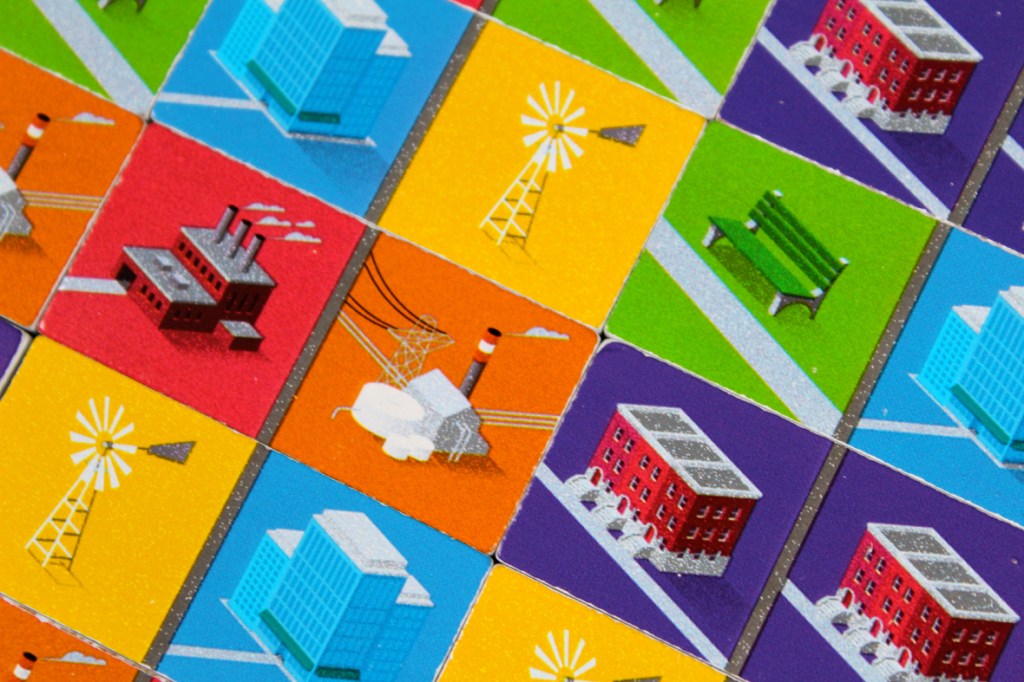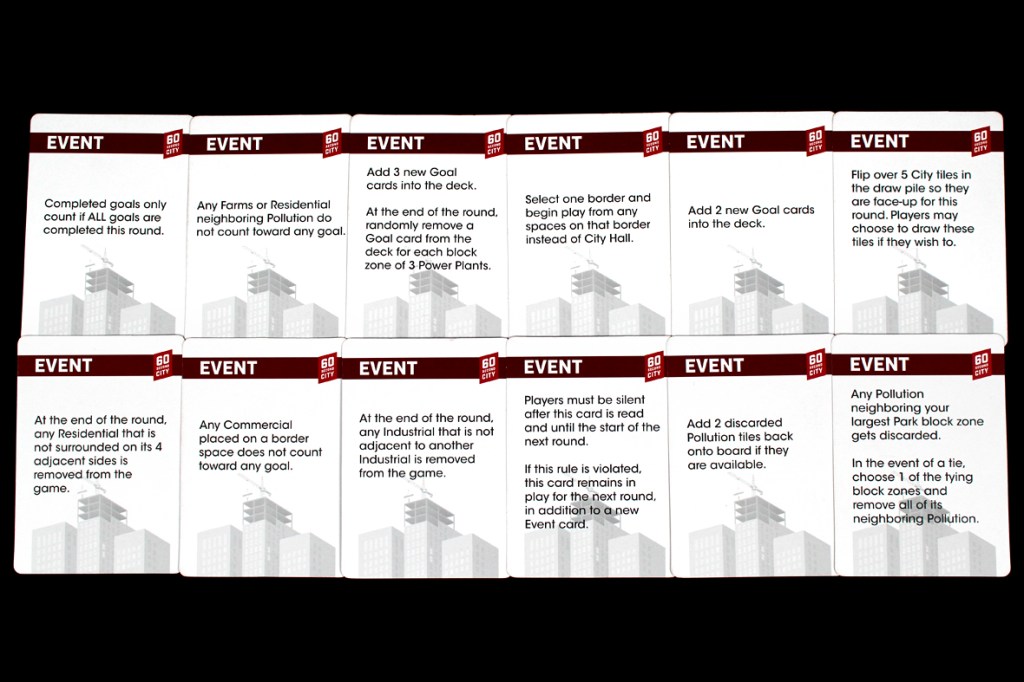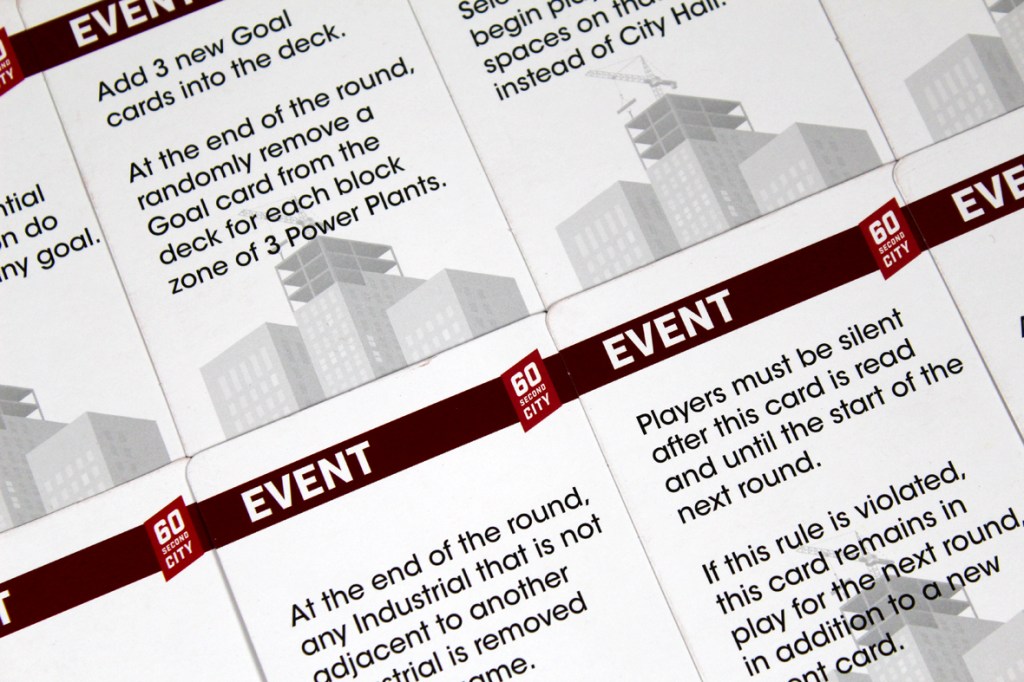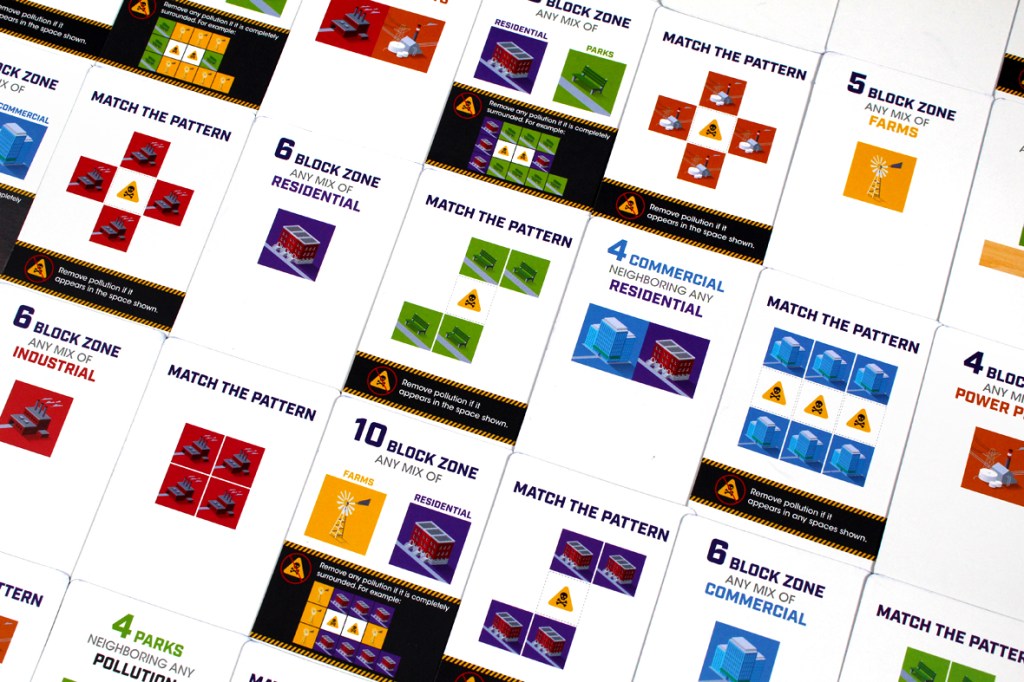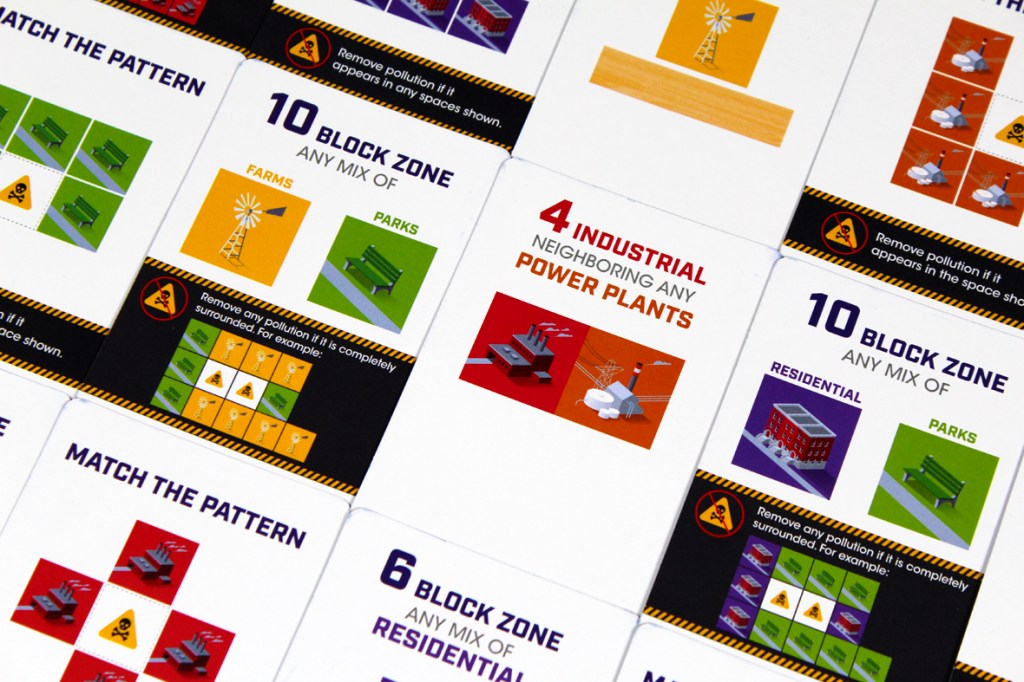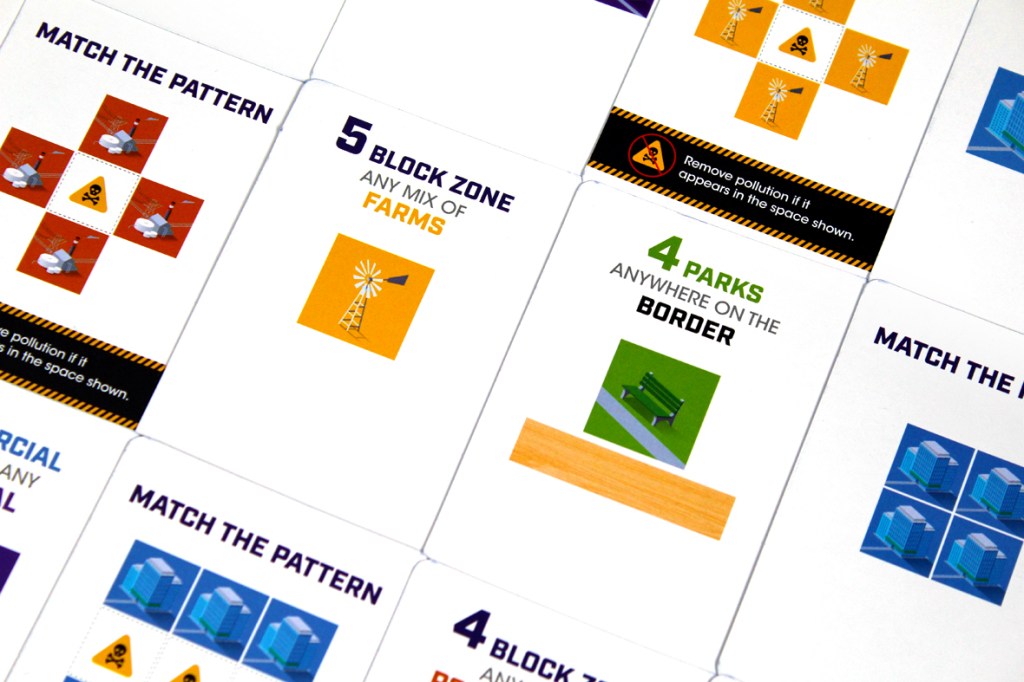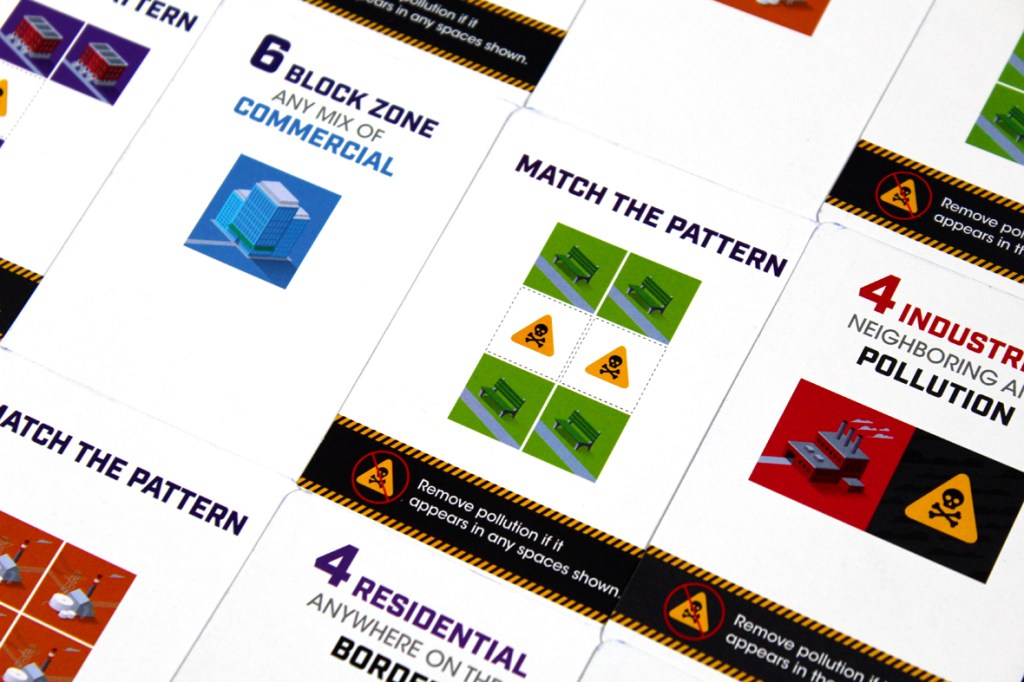
Base price: $18.
2 players.
Play time: 20 – 30 minutes.
BGG | Board Game Atlas
Buy from Target!
Logged plays: 4
Full disclosure: A review copy of 60 Second City was provided by Buffalo Games.
This one’s a bit embarrassing. I try, generally speaking, to line up my reviews such that games that are related in some way are in the same column of the four columns that end up on my front page. That worked amazingly when I was publishing four reviews a week, since I knew exactly where the churn was and how to get things to shake out. That doesn’t work quite as well with three reviews a week, since, every four weeks or something, there’s a gap. That happened with the game I was planning to review this week, and I only noticed it like five days before publishing. Again, frustrating! So, instead, you can have a review of a game I just got and wrote up pretty recently. Usually my receipt-to-review time is pretty long, so this is a rare example of a What’s Eric Playing? Miracle, up from the What’s Eric Playing? Goofer that happened in one of the previous reviews I wrote (which is coming out in two weeks; isn’t time fun). Without further ado, let’s dive into 60 Second City, a new game from Buffalo Games. They’ve been doing a bunch of Target exclusives, and this looks to be within that line as well.
In 60 Second City, you’re here to build a city and you’re on a time budget. How much time? Well, as you might guess, it’s sixty seconds. Five times. So 300 seconds? Not quite. We’ll get into it. But along the way, you’ll have to manage Districts, Events, and the ever-present Pollution. Thankfully, you’re not doing it alone! Your partner is there to help out, and, in my case, occasionally get in your way and do a poor job of communicating. I get stressed sometimes. It’s something I’m working on. Will you be able to build a better city?
Contents
Setup
There’s not a ton here, which I respect. Place the board between both players:
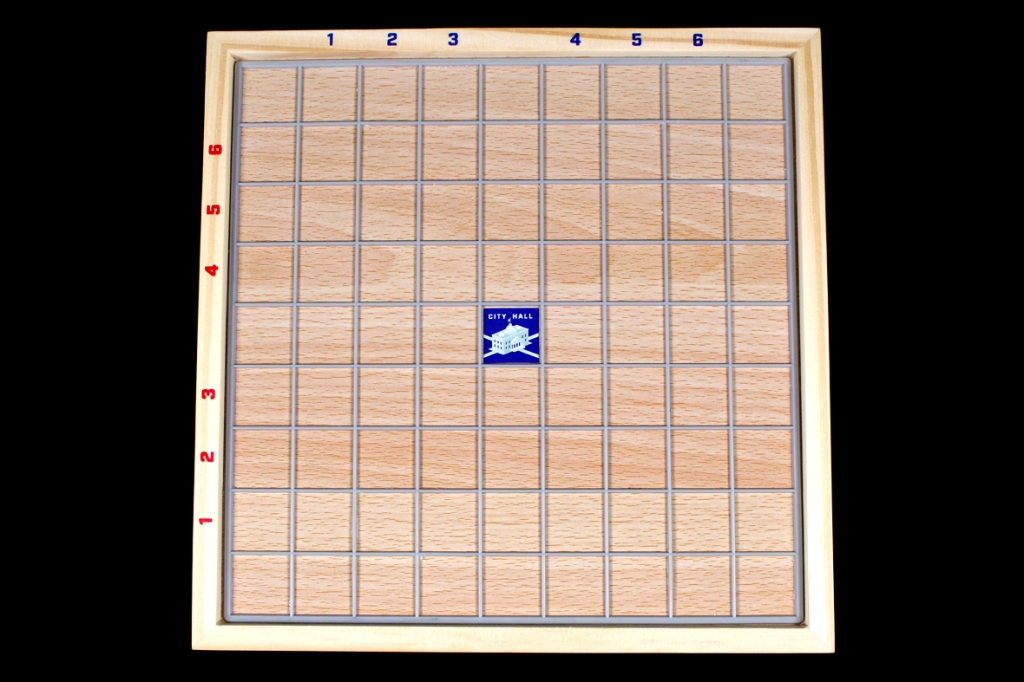
Give each player a die:
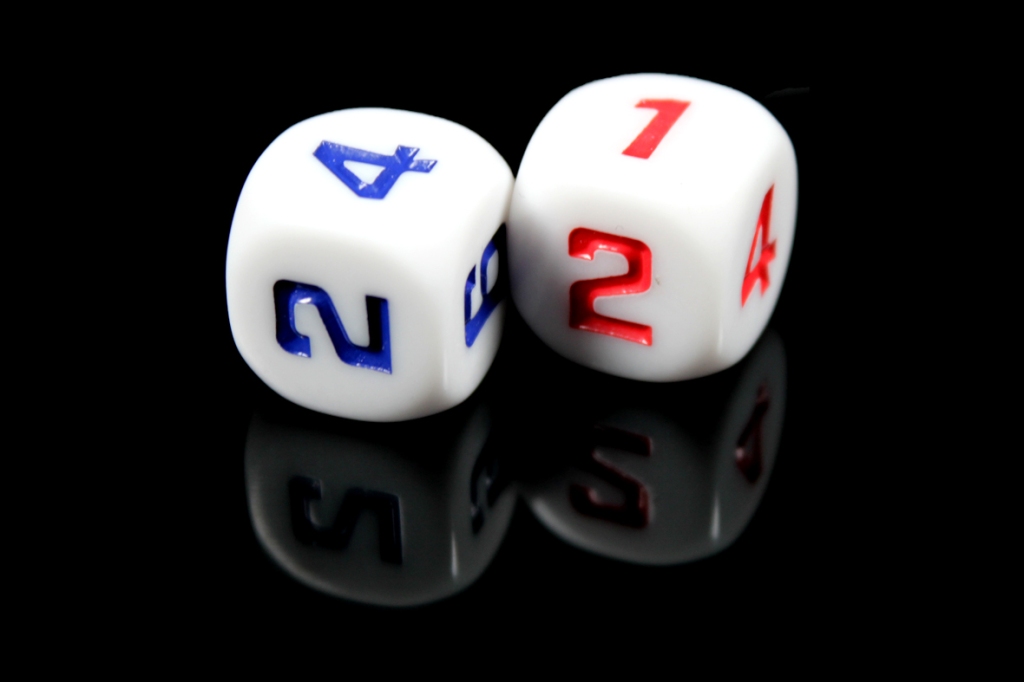
Place the City Tiles face-down and shuffle them:
You should place the Pollution Tiles nearby. The game recommends five stacks of three tiles, but I like keeping them in the bright green token bowl that Netters made for me. It gives them a biohazard vibe.

You’ll need a timer, as well, so get a phone or a stopwatch or whatever the youths are using to keep time. Once you’ve done that, you can choose to play with or without the Event Cards:
Shuffle the Goal Cards:
Depending on your difficulty level, you’ll want to put a certain number in a pile. If you’re new to the genre, try Starter. If you’re experienced with city-building, Sprawlopolis, or real-time games, try starting with Standard.
- Starter: 12 Goal Cards
- Standard: 16 Goal Cards
- Difficult: 20 Goal Cards
- Expert: 24 Goal Cards
Either way, place them face-down and put the rest back in the game box. Once you’ve got all that, you’re good to start!

Gameplay
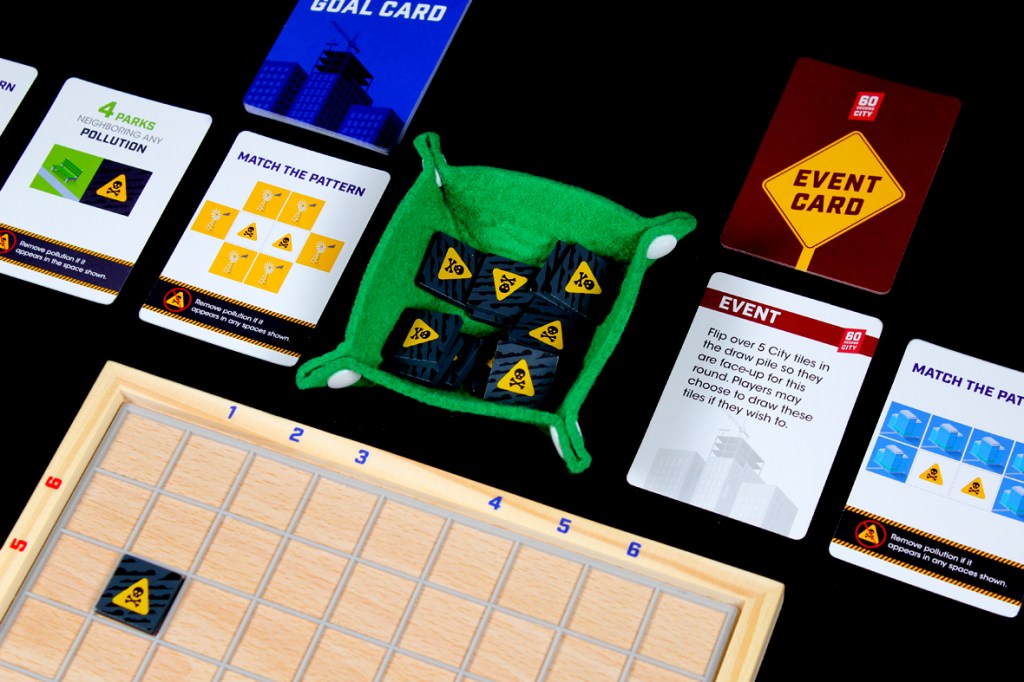
A game of 60 Second City is played over five rounds, as players try and try again to perfect a city to meet the whims of Goal Cards (and occasionally Events). Every round will start with a blank board, so they’ll mostly play the same way. A round has three phases; let’s go through all three.
Round Setup
To start, reveal Goal Cards from the top of the Goal Card deck until there are five in play. If there are fewer than five, between the face-up cards and the remaining cards in the deck, reveal as many as you can. If this is the final (fifth) round, reveal all remaining Goal Cards. Have fun with that.
Then, add three Pollution Tiles to the board! Have each player roll their die, and then place a Pollution Tile on the space indicated by the pair of dice. If there’s already a Pollution Tile there, return the tile you’re holding to the box; you won’t place that one.
Once you’ve done those two things, take some time to look at the Goal Cards and strategize! If you’re playing with Event Cards, reveal an Event Card, as well.
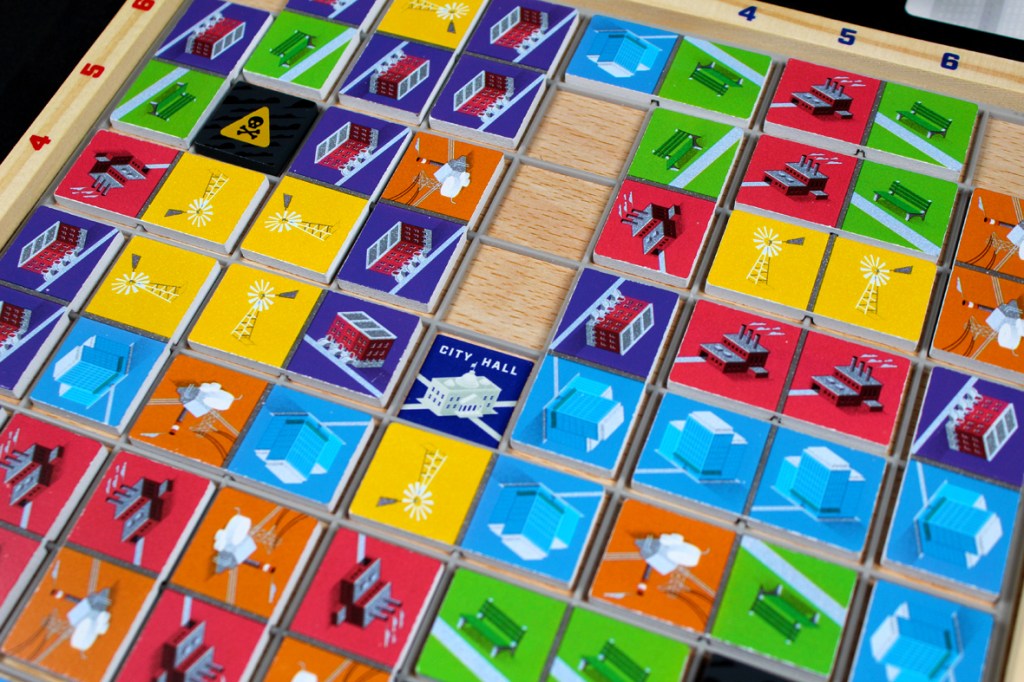
Playing the Round
Once you’re ready, start a sixty-second timer. Each player can hold one City tile in their hand at a time and place it according to the following rules:
- All tiles must be placed adjacent to another City tile or the City Hall tile. Pollution Tiles do not count as City tiles.
- City tiles cannot be played on top of Pollution Tiles. That would be gross.
- City tiles cannot be moved. Too much paperwork. Plus, imagine all the pipework.
Once you’ve placed a tile, draw another. Continue doing so until all legal tile placements are filled or the timer runs out. If you’re still holding a City tile when the timer runs out, you may place it before scoring.
Round Scoring
Now, check all your Goal Cards. If you’ve completed one, discard it. If that Goal Card allows you to remove Pollution Tiles, now’s the time. Return the indicated Pollution Tiles to the box.
If you did not complete certain Goal Cards, they stay in place until the next round. Pollution Tiles that weren’t removed stay, as well.
After settling your goals, remove all the City Tiles and reshuffle them. Then, restart preparing for the round with Round Setup! Continue until the end of the fifth round!

End of Game
The game ends when players have completed all Goal Cards or at the end of the fifth round. Either way, check to see how you did!
- Completed all Goal Cards before the 5th round. Impressive! Your rank is True Urban Visionaries.
- Completed all Goal Cards: Nice work. Your rank is City Architects.
- 1 – 2 Goal Cards Incomplete: Your rank is Master Builders.
- 3 – 4 Goal Cards Incomplete: Your rank is Urban Planning Undergrads.
- 5+ Goal Cards Incomplete: Apprentices!
Player Count Differences
None! This game only supports two players.
Strategy
- Talk to your partner! The game gives you as much time as you want to strategize and plan the round (usually), so talk to your partner about what goals are available, what you think you can do, and where you think you should go with your tile placements. This usually can mean having productive colors to look for, a dump area for colors that are irrelevant to your goals, and then figuring out how to build to be where you need to be. This can also help you align on placements and prevent you making weird errors that block off your partner’s plan. You won’t have much time to chat during the round proper, so getting aligned before the round starts can be pretty critical.
- Look at your goals and plan synergies. This one is mostly just good planning. If you have multiple Goal Cards that concern a few tile colors, it’s worth looking at overlap and making sure that you know where you want everything to end up. I particularly recommend synergies that let you remove Pollution tiles or moving a few colors together for big (6+ block) productions. There are a lot of ways that you can get those to work, but most of them require that you play quickly.
- Some rounds (especially while learning the game) you won’t be able to get every Goal Card accomplished. Make sure you check. There are some Goal Cards that are mutually exclusive (or at least challenging). If you know which ones you care about you can ignore the ones that you don’t need, at first. Keep in mind that if you’re playing on Expert, however, you do kind of need to accomplish every Goal Card every round. But you can surely handle that, can’t you?
- You just won’t have a lot of time, so, prioritizing what you can do might be the best way to move forward. Having a “dump zone” for colors you don’t need that you don’t really need to look at can be clutch. That lets you essentially put your brain into Lizard Brain mode and you just need to respond to “color good? no? bye.” That let us get all of our goals accomplished in one round, a few times. It’s tough, since you can only touch one tile at a time, right? It’s a good bit of challenge.
- Try to eliminate inconvenient Pollution tiles, if you can. They’re just junk, and junk can block you from fulfilling Goal Cards. Thankfully, odds are that you’ll have at least one Goal Card each round that will let you knock out a few Pollution Tiles so that you can start cleaning up the board. Generally, I prioritize those so that you can make sure those tiles are going away.
- Keep in mind that you can only clear 5 Goal Cards at a time, per round, except for the last one. This is something some players don’t really think about. Yes, in the final round, it’s the Wild West and every remaining Goal Card is put in play, but you can’t honestly expect to complete 10 Goal Cards in one round. Maybe you can! If you do, let me know; I want to be proud of you. But planning ahead is how you make sure that you can actually complete all your Goal Cards ahead of schedule.
- Making patterns can be difficult, so make sure that your partner is on the same page. I can get a bit stressed during play, so I can occasionally think that I’m helping and actually hurt my partner, or occasionally vice-versa (much more rarely). Agree on zones where things are going to go and say what tiles you still need if you have a specific need; that way, they won’t dump your tile elsewhere for what they’re working on. As I mentioned earlier, if you can get your needs to overlap and plan around that, that’s usually better.
- Honestly, we found that tapping a card once it was complete was helpful. This is a very quick way to say “the Goal Card is complete; don’t look at it anymore” rather than having to pause play. Saying “done” when you tap the card is also pretty useful? Just having some simple signal in place to indicate this will be pretty helpful. This isn’t Hanabi; that’s not cheating. You’re encouraged to get your plans together with your partner before the round starts, so take advantage of that time!
Pros, Mehs, and Cons
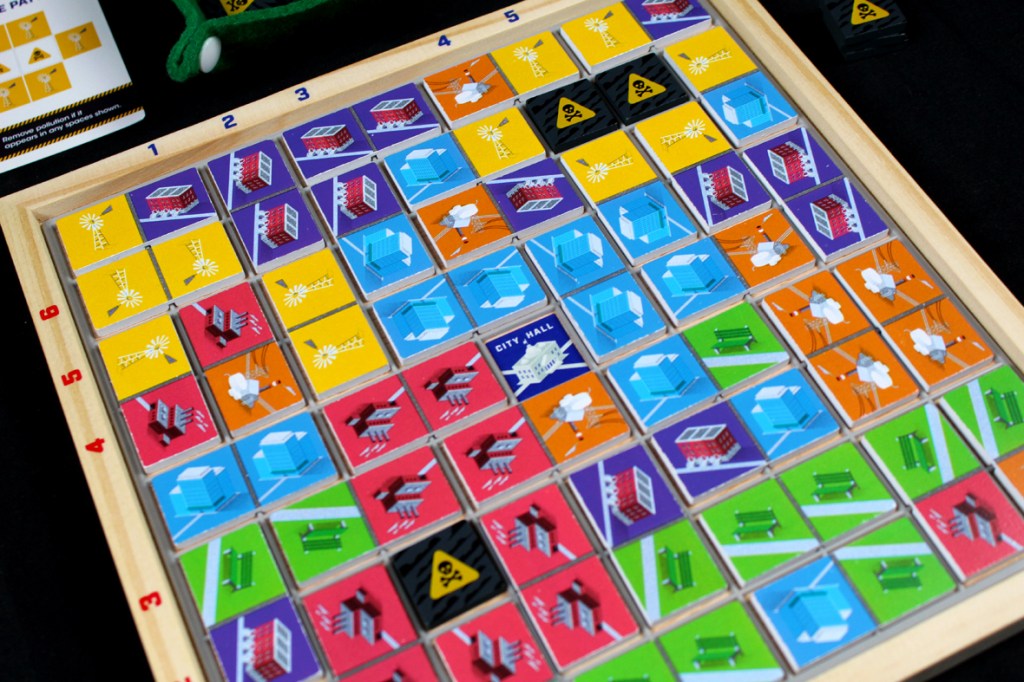
Pros
- It’s very well-produced, for the most part. I think they put the most effort into making sure that the board is the way it is. Not only is it a pretty nicely-produced board (given the materials, especially), but it has a nice grid system that locks the tiles in place when they’re played, so nothing moves around during the game. Especially for a real-time game, you’d expect the cards to get effectively splattered all over the board, otherwise, so I think this is one of the most smartly-designed boards for a game that I’ve seen in a while. It’s just recessed in a very logical way. The tiles are nice, as well.
- I really like the color scheme and art style. 60 Second City went for the “bold colors, clean lines, isometric” art style, and that always resonates with me. It’s not quite as intricate as Unearth, but it still looks pretty great, all things being considered. I’m, unfortunately, a sucker for the isometric style.
- It’s very easy to pick up, which I really appreciate. Honestly, it’s usually just easiest to teach someone by playing a round of it. Even if you miss a few Goal Cards, just walking them through how Goals work, giving them a sense of the timing of it all, and showing what completing certain goals looks like can be really helpful.
- I also really like city-builders! It’s one of my favorite genres of games. I really like games that give the player a sense of progress, and while you reset your progress every round, you do get a good sense of your progress after a round completes. I probably would like it even more if the progress were ludonarratively consistent and not just “make shape from tiles”, but that’s about the best you can do in sixty seconds. If I had one request, I’d say giving the Goal Cards city-themed titles like Center of Industry: 10 Block Zone Any Mix of Industrial and Power Plant would help me feel a bit more invested in the theme, which would be nice.
- I really like games that use dominoes well, mechanically (or thematically). These are probably technically dominoes! At the very least, this reminded me a bit of Kingdomino. I don’t think the King necessarily needs to worry about the crown, but this is another solid domino-laying game. I just like the constraint of having to place two tiles at a time, rather than just one. It forces me to think a bit.
- The pace of the game is really good. The game just moves. I always feel like we’re almost out of time, and we often finish what we wanted to do with 1 – 3 seconds remaining (or we get hit by the buzzer). That’s pretty solidly matched to player speed, and it’s a good feeling. I think that letting players place the tile they’re holding when the buzzer goes off is a very kind thing for the game to do, and I think that leads to a better player experience for this game’s target audience. I can imagine an easy way to make the game a bit tougher is to remove that rule, if you’re house-ruling the game.
- The cooperative elements are flexible and players have space to plan out a strategy before the round starts, which I really like. Again, the game is kind, rather than being brutally difficult. I think there’s still a good bit of challenge, but we can pretty consistently hit City Architects on Standard, which is good. There are also a lot of ways to make the game more challenging or swingy, from Events to additional Goal Cards. There’s room to grow!
- I wouldn’t say the game seems expandable, but I really like the concept and wonder if it could be applied to other genres / made more complex. I could see 60 Second Kingdom or 60 Second University or 60 Second Ocean or something. I would definitely like any of those, especially if they had something to mix things up beyond the core gameplay. I kind of would like if the game were a bit more cognitively intense or required me to think a bit more when I was placing tiles, even if the board were smaller. I don’t see how you would add more to this game, but I would be into a line of 60 Second Games.
- I like the whole Pollution mechanic, generally. It reminds me of Tsuro of the Seas and adding daikaiju to the board. I also like that they both block placement (which can really junk you up with placing dominoes) and they can be removed by Goal Completion. It’s a smart little junking mechanic and it works really well both thematically and mechanically. I appreciate that it adds a small goal for players to focus on without adding so much difficulty that it’s players’ sole focus.
Mehs
- The cards are pretty flimsy. Gotta hit that $25 price point, somehow, and if you’ve got what look to be special-made tiles (even if the wood isn’t like, Super High-Quality Wood), something’s got to give. I’m not terribly surprised it’s the cards, but they’re pretty solidly flimsy. Oh well. Just wobbly; try to be gentle with them.
- Some of the wording on the Goal Cards can be confusing at first, as it takes a little bit to map the city tile color / shapes to their types. This is mostly a first-game problem, but for instance, the “Match the Pattern” cards can be confusing if you don’t realize that having Pollution Tiles in the indicated spots is optional. That vexed us for a few games. Similarly, until you have the districts down-pat, “4 Residential Neighboring Any Parks” can be confusing. You need at least 4 Residential tiles to accomplish that, but if you have one Park with Residential blocks on all sides, that counts. We got a bit confused here, too, but we got there, eventually. The Goal Card Reference is pretty helpful at disambiguating it (and it has good examples).
- Very nitpicky, but having the logo reversed on the other side of the domino’s back doesn’t work for me. Welcome to Mehs, where I just nitpick things about graphic design that make me grouchy! This is one of those things. I just don’t like it. I get that it makes the tiles effectively reversible. I get that it’s aesthetic. It just doesn’t jive with my brain super well.
- The numbers in the rulebook around player scoring don’t match up with the text. This may just be a printer error or something, but under “Master Builder” it suggests players qualify for that rank if they have 1 – 2 incomplete Goal Cards, but the image next to that paragraph says 1 – 4. Similarly, the next two ranks have 5 – 8 and 9+ for 3 – 4 and 5+, which is odd. Just seems like a mistake made it to the printer, but I ignored the image and went with the text instead? Unfortunately, I published this a bit too early for the “how to play” video to go up, so, wasn’t able to verify beforehand. If I can figure out which one is correct, I’ll update the review.
Cons
- There’s one Event Card that’s just extremely difficult (or, at least, swingy, depending on what Goals you draw). Goal Cards vary in difficulty, so the Event Card “you only get to complete Goals if you complete all of your Goals” can be a real doozy. It can really mess up new players (or even moderately-experienced players), so, I suppose that’s why it’s part of the Advanced Game, but in general the Event Cards can be either really helpful or particularly harmful, just depending on what you draw, as well. I still like them (quite a bit), they can just add a big touch of randomness to your game.
- I understand why it doesn’t, but it is a bit odd that a real-time game with a timer in the name doesn’t come with an actual timer for players to use. Again, gotta hit that price point and sand timers are notoriously kind of … uneven? Hard to predict? Inconsistent? There’s probably some overlap between “people who buy luxury hobby items” and “people who own cellphones or kitchen timers or a microwave”, so, I get it. It’s just odd that there isn’t a timer of some kind in there.
Overall: 8.5 / 10
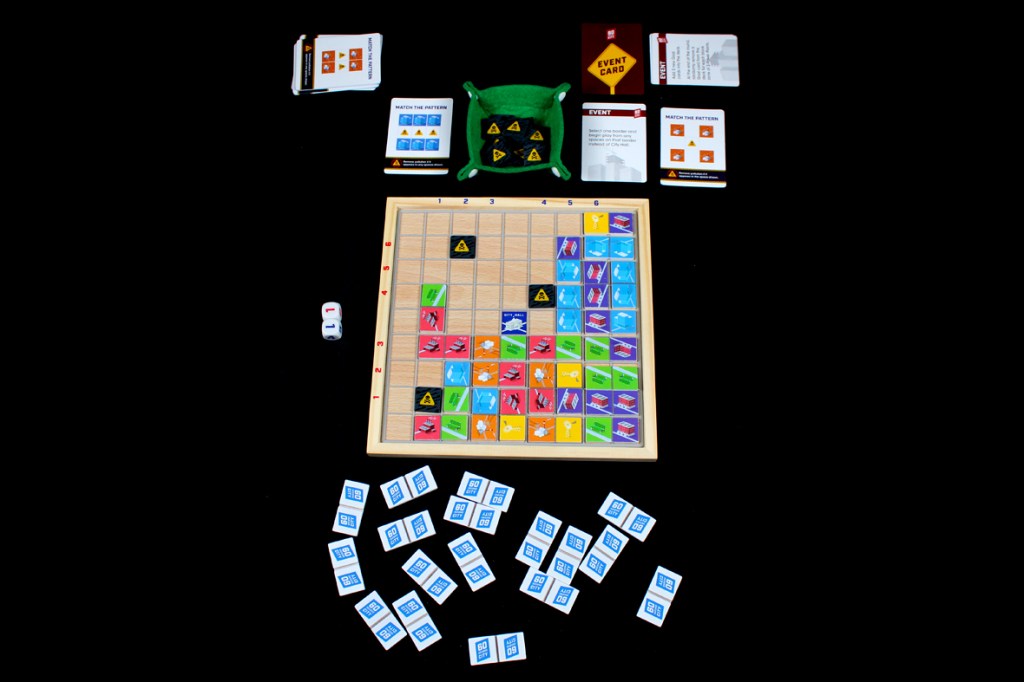
Overall, I was pretty impressed by 60 Second City! I’ll be honest, I enjoyed this enough to be like, “Why am I only hearing about Buffalo Games now?”, and after looking into it, I saw that the Happy Salmon / Most Wanted folks designed this, which doesn’t surprise me. This is a pretty solid title for folks looking for something casual and fun, with production values that I was impressed by. I see this game as a great entry in the “after work” titles, where I want something that challenges me a little bit but isn’t going to force me to really dig in and focus if I’m burnt out after a long day of getting my project effectively cancelled or whatever happened today. Mondays, am I right? Regardless, even my complaints (Event Cards being a bit swingy / no included timer) are relatively minor. This also is the kind of game I’d gift to couples. I enjoy a light cooperative title, and I think giving that to folks is good! This game encourages communication, shared goals, and cooperation, and those are all pretty good things! I’m also a big fan of the game aesthetically, but that’s hardly a surprise. Bold colors, isometric viewpoint on tiles, and some smart design around tile stability all make sure that the game looks great every round, even if I’m frustrated I forgot to take a picture of it for Instagram no fewer than the first 15 rounds I played of it. That’s just a classic Eric Problem, now, I guess. I’m losing the thread of the point, here. I think that 60 Second City is a great game on its own, but I also like it enough that I’m into the idea of exploring what other things we could build on a grid in 60 Seconds. I’m engaged and delighted when I play. I find the Goal Cards are solid micro-goals, and even five of them at the same time is challenging, but doable, so I feel a sense of accomplishment even when we complete two (but especially when we complete five). That means that the game is cultivating delight, which is an excellent place for a game to be. If you’re interested in a quick and delightful city-builder, you love cooperative games, or you’re just looking for a fun title for two players, I’d definitely recommend checking 60 Second City out! I had a very nice time playing it.
If you enjoyed this review and would like to support What’s Eric Playing? in the future, please check out my Patreon. Thanks for reading!

